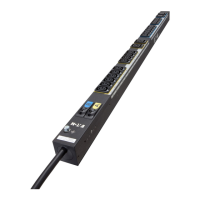Web Interface Operation
Eaton ePDU G3 Operation Manual P-164000277—Rev 1 www.eaton.com/ePDU 103
Read-Only Access
Outlet-Users with read-only access have limited privileges, including:
l
Access to retrieved ePDU up-to-date data and measurements, but cannot change settings for the ePDU
l
Access to retrieved data for the outlets in user-defined groups assigned by the administrator
l
Cannot access the Serial interface; must use the Web interface only
l
Can access the log and notifications submenu, but cannot clear the logs data
l
Cannot configure the TCP/IP, SNMP Global Security, and LDAP or other global settings
l
Cannot upload the communication module configuration file or upgrade the firmware
l
Cannot change his profile or another user’s account
No Access
An Outlet-User (local or remote) with no access privileges is not authorized to access to the Web page.
Session Management
The following session management restrictions apply:
l
There can only be one SuperUser with read-write access rights and up to eight multi-users with configurable
access rights.
l
Only one ePDU-User or Outlet User with read-write access and at least one common outlet can be
logged-in at a time.
l
When the administrator connects, any existing read-write sessions are closed. The other user (or users) will
be asked to authenticate and open a new read-only session.
l
If a user with read-write access is logged in and another user with read-write access wants to log in, the
following message displays: “Another user is logged in with R/W access. Continue as R/O?”
l
ePDU sessions are also limited in the following ways:
- Only five standard sessions without SSL (Secure Sockets Layer) or SSH (Secure Shell) sockets are
allo
wed.
- Only two secure sessions can be r
unning at the same time.
- Only an administrator can have two simultaneous sessions open in HTTP/HTTPS (Hypertext Transfer
P
rotocol / Hypertext Transfer Protocol Secure), Telnet/SSH.
NOTE During an HTTP/HTTPS or Telnet/SSH session, the session times out if there is no
activity for five minutes. After a session times out, you must login again.
Overview
Review/Modify ePDU Data
NOTE Menu selections for ePDU [0], [1], [2], or [3] only display if the ePDUs are configured
in a daisy-chained configuration. If provided, selecting either ePDU [0] or ePDU [1],
[2], or [3] displays the Overview page for the specified ePDU only.
1. Access the Web interface and log in.
2. The PDU: Overview page displays.
3. In the ePDU Information panel, review ePDU identification in
formation.

